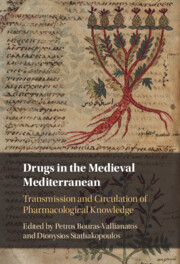Book contents
- Drugs in the Medieval Mediterranean
- Drugs in the Medieval Mediterranean
- Copyright page
- Contents
- Figures
- Tables
- Contributors
- Acknowledgements
- Note to the Reader
- Medieval Mediterranean Pharmacology
- Part I Transmission of Pharmacological Knowledge
- Part II The Borders of Pharmacology
- Chapter 7 Making Magic Happen
- Chapter 8 Remedies or Superstitions
- Chapter 9 When the Doctor Is Not Around
- Chapter 10 Digestive Syrups and After-Dinner Drinks
- Chapter 11 Late Byzantine Alchemical Recipe Books
- Chapter 12 Making Connections between the Medical Properties of Stones and Philosophy in the Work of Albertus Magnus
- Chapter 13 Healing Gifts
- Index
- References
Chapter 7 - Making Magic Happen
Understanding Drugs As Therapeutic Substances in Later Byzantine Sorcery and Beyond
from Part II - The Borders of Pharmacology
Published online by Cambridge University Press: 19 October 2023
- Drugs in the Medieval Mediterranean
- Drugs in the Medieval Mediterranean
- Copyright page
- Contents
- Figures
- Tables
- Contributors
- Acknowledgements
- Note to the Reader
- Medieval Mediterranean Pharmacology
- Part I Transmission of Pharmacological Knowledge
- Part II The Borders of Pharmacology
- Chapter 7 Making Magic Happen
- Chapter 8 Remedies or Superstitions
- Chapter 9 When the Doctor Is Not Around
- Chapter 10 Digestive Syrups and After-Dinner Drinks
- Chapter 11 Late Byzantine Alchemical Recipe Books
- Chapter 12 Making Connections between the Medical Properties of Stones and Philosophy in the Work of Albertus Magnus
- Chapter 13 Healing Gifts
- Index
- References
Summary
When grappling with the extremely uncertain world in which they lived, Byzantine people felt able to choose within a pluralistic mixture of practices and a distinctly diverse set of attitudes, theories, and methodologies. Thinking about ‘drugs’ in Byzantine magic thus involves an exploration of one small part of the fluid spectrum of possible responses that were open to people faced with ill health. Although modern scholars may once have considered these responses under such discrete headings as rational, spiritual, and magical, it is now widely recognised that such distinctions are not applicable. What constituted a drug for the Byzantines, how it was thought to work, and how it might be administered seem to have involved a considerably broader conceptual framework and range of practice than our own. Looking at specific examples of the use of ‘therapeutic substances’ in later Byzantine magic may help us understand this difference.
Keywords
- Type
- Chapter
- Information
- Drugs in the Medieval MediterraneanTransmission and Circulation of Pharmacological Knowledge, pp. 245 - 276Publisher: Cambridge University PressPrint publication year: 2023

